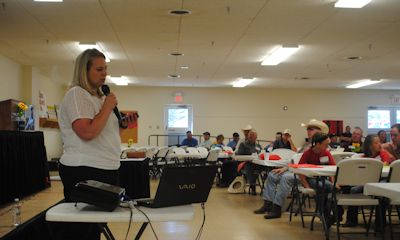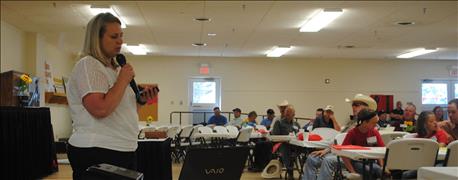
How much risk are you willing and able to take on? That's the question producers need to ask themselves before considering retaining all or partial ownership of their groups of feeder calves during the feeding phase, according to Carrie Lewis Huenink, business development manager with AgriClear, Inc. "The difference between a seller and a marketer is that a seller is a traditional price taker who accepts the price offered," Huenink told producers at the 77th annual Sandhills Cattle Association meeting in Valentine recently. "Marketers actively pursue the price they want."

RISK TOLERANCE: If you are considering retained ownership in all of part of your feeder calves through the feeding phase, you need to understand your tolerance level for risk, says Carrie Lewis Huenink, business development manager with AgriClear, Inc.
She suggested that a marketing plan was essential to success. Here are six straight-forward considerations for developing a market plan for retained ownership.
Determine where your risk tolerance is. "The potential is there for greater losses," Huenink said. "Risk is higher with more investment. The producer assumes more market ownership, so there are more chances for a wreck," she said. According to Huenink, retaining ownership and assuming more risk can hamper cash flow, and producers need to be able to ride out market volatility because animals that are ready to be harvested cannot wait.
Determine your program goals. Retaining ownership of some of the calves may also identify weaknesses in a program. "This can be considered a negative, but it could be turned into a positive" depending on what the producer did with that information, she explained.
Know your cattle. The benefits of retained ownership could include a potential for greater return and the ability to gain information through the feeding process that will help the operation overall, she said. "It may increase the future marketability of the calves to help you find and retain good genetics in the operation," she explained. "It can help you get paid on your investment."
Know what your cattle are worth. She said that producers can become their own marketers, and one way to add value to their products is to retain ownership in all or part of the calves going to the feedlot. "Assuming more risk also means added value for sale at the end point," Huenink said.
Know your cost of production. There are a number of online tools available through the University of Nebraska and other outlets to help determine feed costs and overall budget expenses.
Know what can be done to change variables that will make a difference with your program. Huenink said that taking information about potential weaknesses in the feeding program or genetics and making changes to overcome these obstacles can help the overall bottomline.
You can learn more about developing a cattle marketing plan by contacting Huenink at [email protected].
About the Author(s)
You May Also Like






